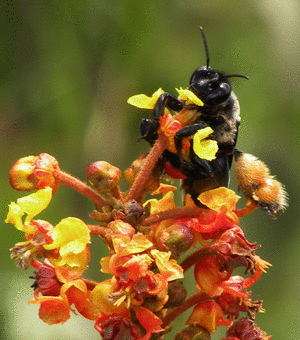Simone C. Cappellari Rabeling, PhD
About me

I am an evolutionary ecologist interested in plant-pollinator interactions at the species and community levels. My research focuses on the community ecology and evolutionary ecology of pollination in highly diverse habitats. I am particularly interested in specialized systems and the influence of specialization on structural properties of plant-pollinator communities as well as mechanisms promoting the coexistence of specialists in nature. For my research, I study aspects of plant reproductive biology and pollination in the field and use niche ecology analyses and pollination network theory to investigate how species traits influence community composition and dynamics. Most of my research focuses on Neotropical habitats of South America and the plant family Malpighiaceae. I recently joined the Plant Evolutionary Biology Department at the University of Hohenheim where I started to work in collaboration with Prof. Philipp Schlüter on the evolutionary ecology of deceptive pollination in the genus Ophrys.

Current projects
- Community ecology of Cerrado plants
- Niche ecology of Malpighiaceae
- Evolutionary ecology of Ophrys pollination in the Mediterranean region
Short CV
| 1996 – 1999 | Biology studies at PUCRS University in Brazil |
| 1999 – 2000 | DAAD Student Fellow in Biology, Eberhard Karls University of Tübingen, Germany |
| 2003 | Diploma in Biology studies at Eberhard Karls University of Tübingen, Germany |
| 2011 | PhD in Ecology, Evolution and Behavior, The University of Texas at Austin, USA |
| 2011 – 2013 | Postdoctoral Research Fellow, Department of Organismic and Evolutionary Biology, Harvard University Herbarium, USA (with maternity leave in 2013) |
| 2014 – 2016 | Postdoctoral Researcher, Department of Biology, University of Rochester (with maternity leave in 2015) |
| 2017 | Postdoctoral Researcher, School of Life Sciences, Arizona State University, USA |
| 2018 – 2021 | Research Assistant Professor, School of Life Sciences, Arizona State University, USA |
| 2022 – present | Carl-Zeiss Principal Investigator, Department of Plant Evolutionary Biology, University of Hohenheim, Stuttgart, Germany |
Publications
13. Cappellari-Rabeling, S. C., R. Tidon, J. L. Neff, B. B. Simpson and S. Pawar. (2019) Seasonal variation of a plant-pollinator network in the Brazilian Cerrado: implications for community structure and robustness. PLoS ONE 14(12): e0224997. [https://doi.org/10.1371/journal.pone.0224997] |
|---|
12. Haleem M. A., S. C. Cappellari, B. B. Simpson and A. J. Marsaioli (2015) Pterandric acid - its isolation, synthesis and stereochemistry. Natural Products Communications 10: 99-102. |
11. Cappellari, S. C., H. Schaefer and C. C. Davis. (2013) Pollen or pollinators – which came first? Current Biology 23: R316-8. |
| 10. Cappellari, S. C., G. A. R. Melo, A. J. C. Aguiar and J. L. Neff. (2012) Floral oil collection by male Tetrapedia bees (Hymenoptera: Apidae: Tetrapediini). Apidologie 43: 39-50. |
9. Cappellari, S. C. (2011). Plant-Pollinator Interactions and their Relevance for Conservation of the Cerrado Vegetation in the Reserva Ecológica of IBGE (in Portuguese). Book Chapter. In: RECOR: Biodiversity, Anthropomorphic Pressures and Environmental Management; vol. I, ed. Mauro C. L. Brito. Brazilian Institute of Geography and Statistics, Federal Government of Brazil Press, Brasília. |
8. Cappellari, S. C., M. A. Haleem, A. Marsaioli, R. Tidon and B. B. Simpson. (2011) Pterandra pyroidea: a case of pollination shift within Neotropical Malpighiaceae. Annals of Botany 107: 1323-1334. |
7. Cappellari, S. C. (2011) Evolutionary ecology of Malpighiaceae pollination at the species and community levels. Doctoral Dissertation, Section of Integrative Biology, The University of Texas at Austin. |
6. Cappellari, S. C. and B. Harter-Marques. (2010) First report of scent collection by male orchid bees (Apidae: Euglossini) from terrestrial mushrooms in southern Brazil. Journal of the Kansas Entomological Society 83: 264-266. |
| 5. Cappellari, S. C., B. Harter-Marques, P. Aumeier and W. Engels (2009). Mecardonia tenella (Plantaginaceae) attracts oil-, perfume-, and pollen-gathering bees in Southern Brazil. Biotropica 41: 721-729. |
4. Rabeling, C., J. L. Neto, S. C. Cappellari, I. Santos, U. G. Mueller and M. Bacci Jr. (2009) Thelytokous parthenogenesis in the fungus-gardening ant Mycocepurus smithii (Hymenoptera: Formicidae). PLOS ONE 4(8): e6781. |
3. Cappellari, S. C., P. Aumeier, B. Harter-Marques and W. Engels (2003). Male orchid bees collect from oil-secreting flowers in southern Brazil. Apidologie 34: 486-487. |
2. Cappellari, S. C. (2003). Flowers of Mecardonia tenella (Scrophulariaceae) as alternative sources of volatiles for males of orchid bees (Apidae: Euglossini), case study Pró-Mata, Rio Grande do Sul, Brazil. Master Thesis, Institute of Biology, Eberhard Karls Universität Tübingen. |
1. Cappellari, S. C., B. Harter, A. Zillikens, J. Steiner and W. Engels (2002). Comparison of orchid bee diversity in fragments of Araucaria- and Atlantic-rainforests of Southern Brazil. Apidologie 33: 517-518. |
